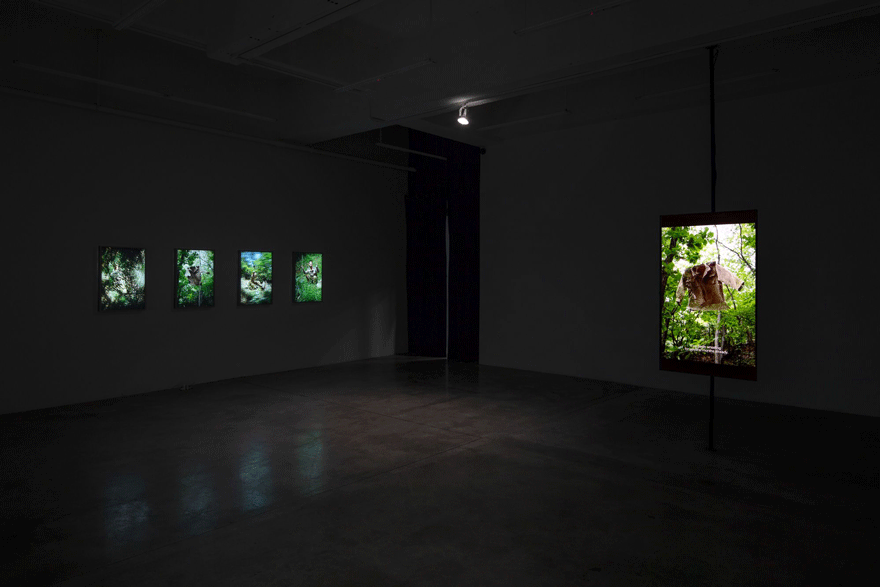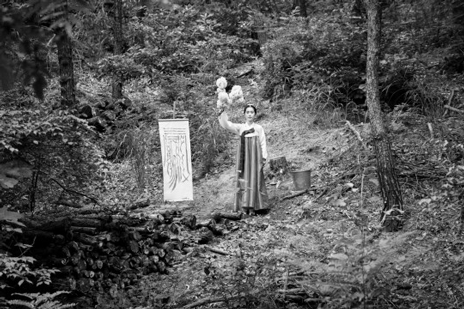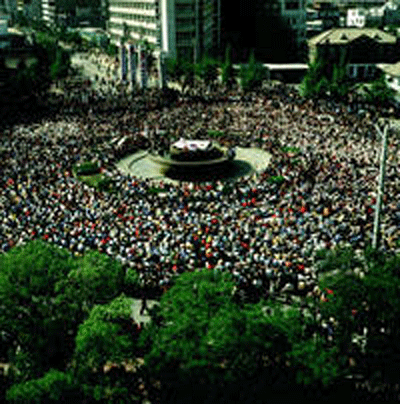Park Chan-Kyong's Citizens Forests invites the audience into the tension between Korea’s past and present.
The three-channel, black and white installation discusses key conflicts in South Korea’s social and political history, outlining the United Nations’ Sustainable Development Goal (SDG) 16 on Just, Peaceful, and Inclusive Societies. Through a combination of film, video and photography, Park creates “an allegory of modern-day Korea,” according to Tina Kim Gallery’s press release.

Park brings the audience into a dark hallway where ghosts emerge from the forests, illustrating the concept of Asian Gothic while depicting the tragic events of the 1894 Donghak Uprising, the Korean War, the 1980 Gwangju Uprising, and the 2014 Sewol Ferry Disaster.
“I wanted to show the distance between spirits and people like us,” Park said in an interview with Kadist.
Inspired by Oh Yoon’s incomplete painting The Lemures and Kim Soo-Young’s poem Colossal Roots, Park depicts the two works’ narrative structure in a panoramic frame similar to traditional shan shui scroll paintings.
Similar to Oh Yoon, Park incorporates elements of gut from the Korean shaman ritual, where the song of gut at the end of the ritual invites civilized spirits before sending them off. According to Park, “In Shamanism, there is a strong perspective that does not treat ordinary people as an object nor a classified tool.”

This connects to Park’s reflection on Kim’s poem about how Kim felt towards tradition and the discontinuity of tradition. “I wanted to imbue those complicated emotions and his awareness into my video work, Citizen’s Forest,” Park said.
Park uses the term Asian Gothic to describe his works, where there are ancient images used in contemporary media. Combined with the art concept of unheimlich, a strange, or “uncanny” feeling created when the artist puts familiar subjects in unfamiliar settings, Park illustrates the tensions in Korean history.
“In East Asia, for example, Korean society was cut off from its tradition very rapidly and violently through colonization and the devastating Korean War,” he said. “In other words, the ineffable emotions of returning home, but home not feeling like home.”
As noted by Frieze’s article, Park reflects on how the country’s economic progression makes the past “an unfamiliar, almost ghostly, figure.”

Korea is often said to experience a psychosocial feeling that is exclusive to the country. Known as ‘Han’ - meaning a feeling of deep-seated injustice, oppression and anger that one cannot overcome -, it is a word that has no accurate English translation but is so imbued in the fabric of the country’s and people’s pores from centuries of recurrent Japanese colonialism, lower-class repression by Korean emperors and modern-day civil war, dictatorship and fervent chaebol (family-run conglomerate) corruption. It is what makes much of Korea’s cultural production, from its Parasite-like noir films to ballad music, so specifically Korean.
Citizens Forest alludes to four events: the Tonghak Uprising, the Korean War, Gwangju Uprising and the Sewol Ferry Disaster, which are significant moments where the government failed to uphold justice and peace. “The result of that kind of history is a reconnection with a painful tradition,” Park said.
According to “The Tonghak Rebellion: Harbinger of Korean Nationalism” by historian Key Ray Chong, the Tonghaks who followed the new Korean religion founded by Ch’oe Cheu, called for social reform but the government criminalized them for public peace disturbance.
However, the brutal oppression of those who did not agree with the government, including the Tonghaks, Confucian scholars and peasants, resulted in a significant rebellion. Chong notes that this rebellion “set a cornerstone for Korean nationalism.”
The Korean War was another significant traumatic social and political historical event, resulting in the splitting of North and South Korea. Just as it ended in 1953, South Korea saw another conflict in 1980: the Gwangju Uprising.
UNESCO notes this event as a “democratic uprising against the military regime in Gwangju” after the assassination of President Jeong-hui Park by the director of the Korean Central Intelligence Agency (KCIA). While the people thought the death of this authoritarian dictator would yield democracy, another military coup seized power and imposed martial law.

On May 18th, civilians peacefully protested against the martial law decree but were met by brutal assaults. By May 27th, 1980, the UNESCO report cites 5,100 individuals affected in total. But survivors continued to suffer from physical and emotional trauma from the paratroopers’ attacks.
Years later, the Sewol Ferry Disaster shook the nation again. According to Choe Sang-Hun from the New York Times, more than 300 people died because profit was put before safety. There was twice the legal limit of cargo on deck, and the cars, trucks, and shipping containers were improperly secured.
“The Sewol sank because of greed,” he writes.
All the events featured in Park’s installation highlight the need for more just institutions. As SDG 16.1 states, the reduction of all forms of violence is necessary for a peaceful society. Harming civilians who express dissent directly opposes SDG 16.
Park said, “I searched for a way to mourn their deaths through my work of video production.”
There must be public transparency as well, outlined by SDG 16.10. The Sewol Ferry Disaster is a prime example of corruption and greed, and despite new laws put in place after the traumatic event, there is still no great change.
Five years later, Choe Sang-hun notes, “The government itself has declined to require changes at ports that experts say would dramatically increase safety by making it easier to catch cargo cheaters. Officials rejected the fixes as too costly.”
The necessary conversations are not complete, and there must be continuous changes to ensure a just and peaceful society. As Park said, “The focal interest of my work is about how to revive the discussions that were once so fervent.”
